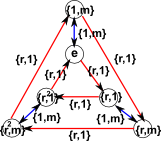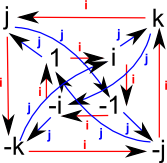If N is a subgroup of G then N is a normal subgroup if:
g N = N g
for all g in G
This does not necessarily mean that g n = n g for all g![]() G, n
G, n![]() N but it means that the set {g N} is the same as the set {N g} or, in other words,
N but it means that the set {g N} is the same as the set {N g} or, in other words,
g n = n' g
That is, if we choose an n in N then n' will also be a member of N (although not necessarily the same member).
If we multiply the above equation by g-1 we get:
n' = g n g-1
where:
- g
 G
G - n
 N
N - n'
 N
N
This second form is probably the best way to test if N is a normal subgroup.
Calculation of G/N
we calculate the set:
g N | g![]() G
G
This will be the group G/N under the operation
(a N) (b N) = a b N
Example 1
Lets take the example of C3×C2 :
| generator | cayley graph | table | ||||||||||||||||||||||||||||||||||||
|---|---|---|---|---|---|---|---|---|---|---|---|---|---|---|---|---|---|---|---|---|---|---|---|---|---|---|---|---|---|---|---|---|---|---|---|---|---|---|
| <m,r | m²,r³,rm=mr> |  |
|
In this example we will test if C3 is a normal subgroup and then divide by it to check that the result is C2.
First we need to know the inverse function, to do this we take a particular column, go down until we get to the identity element '1' and then read out the row:
| x | x-1 |
|---|---|
| 1 | 1 |
| r | r² |
| r² | r |
| m | m |
| rm | r²m |
| r²m | rm |
let R = the elements of C3, that is, 1 , r and r²:
| x | x 1 x-1 | x r x-1 | x r² x-1 |
|---|---|---|---|
| 1 | 1 1 1 = 1 | 1 r 1 = r | 1 r² 1 = r |
| r | r² 1 r² = r | r² r r² = r² | r² r² r² = 1 |
| r² | r 1 r = r² | r r r = 1 | r r² r = r |
| m | m 1 m = 1 | m r m = r | m r² m = r² |
| rm | r²m 1 rm = 1 | r²m r rm = r | r²m r² rm = r² |
| r²m | rm 1 r²m = 1 | rm r r²m = r | rm r² r²m = r² |
So the result is always a member of C3 so it is a normal subgroup. We can now try divideing by C3 as follows:
The result of this division has elements R and Rm:
| R | Rm |
| Rm | R |
Example 2 - divide C by Z2
G = Complex numbers = C
N = Z2
Test for Normal Subgroup
| x | x N x-1 |
|---|---|
| 1 | 1 {1,-1} 1 = {1,-1} |
| -1 | -1 {1,-1} -1 = {1,-1} |
| i | i {1,-1} -i = {1,-1} |
| -i | -i {1,-1} i = {1,-1} |
So x N x-1 is a member of N for every x which means that G/N will be a group and we can go on to calculate it.
Calculation of G/N
Elements of G/N are a•N:
1•{1,-1} = {1,-1}
-1•{1,-1} = {-1,1}
i•{1,-1} = {i,-i}
-i•{1,-1} = {-i,i}
so the elements are:
{1,-1} and {i,-i}
Example 3 divide H by C
G is the group of quaternions H:
Cayley Table |
Cayley Graph |
|||||||||||||||||||||||||
|
 |
Note: in this example I have not shown the negative elements so where i is shown we also have -i and so on for the other elements.
We want to divide it by C to get H/C
Test for Normal Subgroup
| x | x K x-1 |
|---|---|
| 1 | 1 {1,i} 1 = {1,i} |
| i | i {1,i} -i = {-1,-i} |
| j | j {1,i} -j = {-1,-i} |
| k | k {1,i} -k = {-1,-i} |
So x K x-1 is a member of K for every x which means that G/K will be a group and we can go on to calculate it.
Calculation of G/N
Elements of G/N are a•N:
1•{1,i} = {1,i}
i•{1,i} = {-1,i}
j•{1,i} = {j,-k}
k•{1,i} = {k,-j}
So the elements are:
{±1,±i} and {±j,±k}
which gives the multipication table:
| a*b | {±1,±i} | {±j,±k} |
| {±1,±i} | {±1,±i} | {±j,±k} |
| {±j,±k} | {±j,±k} | {±1,±i} |